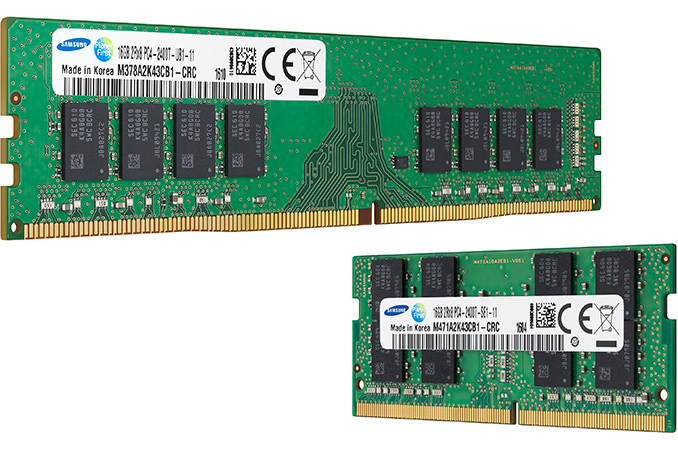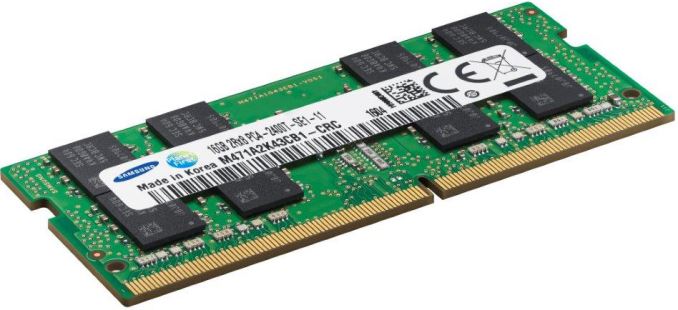Samsung Begins To Produce DDR4 Memory Using '10nm Class' Process Tech
by Anton Shilov on April 7, 2016 1:00 PM EST
Samsung Electronics has started to manufacture DDR4 memory using its new '10nm class' production technology. '10nm class', by definition, implies sub-20nm but without fully disclosing the methodology, similar to the first sub-20nm NAND production that used 1x/1y terminology. By using a sub-20 nm fabrication process, this typically helps a company make ICs/DRAM cheaper, faster and more energy efficient, depending on the process complexity. In this case, Samsung continues to use ArF (argon fluoride) immersion lithography tools with quadruple patterning to make its latest memory, which indicates a very high complexity of the new process tech. What is also important is that the new DRAMs feature Samsung’s new memory cell structure.
In the news today, Samsung’s new DDR4 memory chips are produced using 10nm-class manufacturing technology, have 8 Gb capacity, and can operate at 3200 Mbit/s data rate (DDR4-3200). In addition, the new DRAM devices are reported to consume 10 – 20% less power than equivalent DDR4 memory ICs made using a 20 nm fabrication process, based on tests conducted by the memory maker. Finally, Samsung can produce 30% more 8 Gb chips on a single 300 mm wafer thanks to the new manufacturing technology, which will lower their costs once their yields match those of current-gen chips due to having more chips per wafer.
Samsung does not disclose many details about its production process, such as its smallest half-pitch size (which gives actual names to DRAM manufacturing technologies, such as 20 nm or 25 nm). What we do know is that the new tech stacks very narrow cylinder-shaped capacitors on top of transistors, which implies a new DRAM cell structure (4F2?). Manufacturers of memory have historically changed the structures of DRAM cells every five or six years, and each change represents a major technology challenge as the density changes. Samsung says that it has refined the dielectric layer deposition technology and enabled substantial performance improvements, which may mean that the new memory chips can have a higher clock-rate potential than Samsung’s existing DRAMs, or more units will pass the base tests. If this is the case, if we extrapolate, this may open doors to DDR4 memory modules with unprecedented data rates (e.g., higher than DDR4-4400). Nonetheless, use of quadruple patterning significantly increases the complexity of manufacturing, which may somewhat slow down the ramp up of the new memory ICs and cause delays in increased yield refinements.
Samsung claims that later this year it intends to use its 1x nm manufacturing technology to make LPDDR memory with increased capacity, which should help makers of smartphones, tablets and notebooks boost the amount of DRAM inside their devices or reduce pricing.
Use of the sub-20 nm process technology to produce 8 Gb DDR4 chips should make such DRAM ICs cheaper (eventually), which will help PC and server makers to install more memory without increasing prices of their products. At press time, one 8 Gb DDR4 chip costs $4.688, according to DRAMeXchange. By contrast, a 4 Gb DDR4 IC is priced at $1.672. Therefore, using low-capacity chips is still cheaper than using high-capacity DRAM devices. Meanwhile, if you are building servers, you might not have a choice but to utilize 8 Gb chips to create high-end memory modules (i.e., with 128 GB capacities). For that reason, for server manufacturers, Samsung’s new 8 Gb DDR4 chips should be useful.
Source: Samsung
















36 Comments
View All Comments
Shadowmaster625 - Thursday, April 7, 2016 - link
It's funny how back in 2010 I bought 8 GB of DDR3 for $5 per GB. And now after 6 years, memory still costs $5 per GB even though the size of the silicon has shrunk by what 70%? Greedy ...plopke - Thursday, April 7, 2016 - link
I have no clue where you are coming from , 16GB DDR4 is as low as 65 dollars and still dropping.Most new memory types start of extremely expensive then they go down in price a lot to finish off their lifetime riding low supply and still compatibility demand so expensive to very exenspive end of life. Taking speed in consideration i think you can buy soon double the amount of DDR4 over DDR3 since prices of DDR4 are still goign down.
Not to mention Research , New fabrication technology , Fixed Cost , Speed improvements, Inflation , A company trying to make money , greedy? Urgh , everybody wants to be rhich but for some reason it may only happen to them.
plopke - Thursday, April 7, 2016 - link
Forgot the most important one , supply and demand ...Samus - Saturday, April 9, 2016 - link
Without a doubt memory has been dropping in price consistently (although incrementally) over the last 10 years. The last spike was late 2008-early 2009 when DDR3 launched. By contrast, the spike for DDR4 was incredibly short...it DDR4 is now cheaper than DDR3 and it only took 4 months. as many have said, supply and demand. Demand for DDR3 surged through much of 2009 because all the platforms hit the market and overall PC demand was figuratively high. There were huge energy and performance improvements over DDR2. Nehalem, the first ten Core microarchitecture launched and the IPC gains were huge over the Core 2. Xeon and server platforms launched based on the X58/C200 chipsets.My comparison, Skylake is the only platform that uses DDR4, and unlike in 2009, it doesn't require it. Half of Skylake platforms are DDR3, including mobile. AMD has no DDR4 platforms. And no GPU's are using it. GPU's have been using DDR3 heavily since its launch in 2008. And with new GDDR5 technology and HBM supplementing DDR in the high performance segment, I doubt DDR4 will find a place in GPU platforms anytime soon unless DDR3 becomes cost prohibitive.
All of this is actually good news for Skylake, because with Intel dropping prices of the CPU's below that of Haswell/Broadwell, and DDR4 remaining cheaper than DDR3 because of low demand, anyone building a new PC is obviously going to use Skylake, including OEM's, and that's good for the consumer because it will actually be cheaper than the previous few generations of PC's based on DDR3.
High supply and low demand is always good for consumers that have demand.
DanNeely - Saturday, April 9, 2016 - link
I disagree with one part of your assessment. With the price gap nearly gone, DDR4 offering double the potential bandwdith of DDR3, and low end GPUs being notoriously bandwidth starved; I'd be shocked if the next generation of low end GPUs don't use DDR4. The only question is if AMD/nVidia will actually release them this year or wait until next. The 14/16nm die shrink for thier high end parts has to be consuming a very large chunk of their attention for the year; but letting the other company leapfrog them in performance on the high volume market segment would be bad, so it's possible both are going to rush out a low end DDR4 chip this year to make sure they're not scooped by the other.niva - Thursday, April 7, 2016 - link
No, that's less than $5 for an 8 Gb chip, used to make modules that will be with huge capacities (128 GB as stated in the article.) Vastly better, higher performance memory than what you bought in 2010. Go find your old memory that you bought in 2010 and check out it's price today, I'm sure it's selling for less, though you do bring up a valid point, it ate a lot of silicon so the raw materials used cost more.yuhong - Thursday, April 7, 2016 - link
Technically 8Gbit equals 1GB. The problem is that 4Gbit is currently mainstream.bcronce - Friday, April 8, 2016 - link
I paid $100 for 32GiB(2x16GiB) of DDR4 low latency high speed G.Skill memory 3 months ago. That's $3.13/GiB and would have been closer to $2.5 if I didn't go for premium overclocking memory. Looks like prices have gone up a bit since, but they tend to be low around tax season.Pork@III - Thursday, April 7, 2016 - link
Fake 10nm. Bad, bad Samsung :Dtheduckofdeath - Friday, April 8, 2016 - link
Read much?